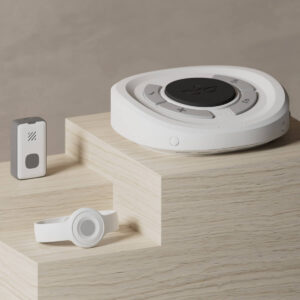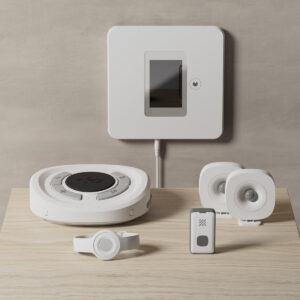Aloe Care Review
Aloe Care Health combines the tried-and-true approach of an old-school medical alert button with newfangled motion, temperature, and fall sensors placed around your home. If you’re feeling a little too stubborn to summon help or you simply can’t, Aloe Care’s smart technology lets your loved ones know that something’s wrong and makes it easy for them to communicate with each other.
We love Aloe Care’s fresh take on the medical alert industry and believe it’s worth the price.

Call to order and get up to 75% off select Aloe Care Health packages.
Info current as of publish date. Offers and availability may vary by location and are subject to change.
Aloe Care cost
Aloe Care costs about $25 to $50 per month based on your equipment package. It’s also one of the few medical alert companies to charge an up-front equipment fee, which ranges between about $100 and $300.
Aloe Care’s neither the most affordable medical alert system nor the most expensive, but we appreciate its basic pricing structure. Many other companies nickel and dime their customers with monthly add-ons, charging extra for every wall button, pendant, or feature you want to add to the system. Aloe Care’s pricing is refreshingly straightforward.
We hope this doesn’t change in the future when the company adds à la carte options.
Is Aloe Care right for you?
Aloe Care may be right for you in these scenarios:
- You want an in-home system. This is where Aloe Care shines. Although Aloe Care does sell a mobile system, other companies offer the same tech in more discreet devices.
- You don’t want to wear a help button. They’re optional, thanks to Aloe Care’s motion sensors, voice-activated technology, and wall-mounted fall detection sensor.
-
Your fall risk is pretty low. Aloe Care assumes you’ll slip and fall in the bathroom, since this is where they recommend installing the automatic fall detection sensor. If you have a health concern that makes you pass out or feel dizzy when getting up from a chair, for example, we recommend wearing the Phillips Lifeline AutoAlert or one of our other top picks for fall detection.
- You want your friends and family to quit worrying about you (at least a little). The Aloe Care app keeps everyone up to speed. You don’t even have to log into the app yourself—it provides automatic updates to the people in your Care Circle thanks to the Smart Hub’s sensors.
- You’re hesitant about “bothering” professional monitors and first responders. First, know that you’re not bothering anyone. People like being helpful and you deserve to be helped. Second, Aloe Care gives you the option of directly contacting your friends and family instead of using the monitoring center as a middleman.
Aloe Care contracts and warranties
You don’t have to sign a contract with Aloe Care, so you can cancel at any time without worrying about termination fees. Service is offered on a month-to-month basis, with the option of paying for a full year up front.
Aloe Care does have a few fine-print policies worth noting:
- Your monthly rate can increase at any time. The only way to lock in your rate is to purchase a full year’s service in advance. Even then, the rate may increase for the next year of service.
- Aloe Care charges late fees. You’ll be hit with a 1.5% late fee per missed month, plus a 5% administrative fee per late payment.
On a positive note, Aloe Care offers a 30-day trial period and a one-year warranty.
Aloe Care equipment
Aloe Care sells four equipment packages. There’s currently no à la carte shop, but the company hopes to provide that in the future.
Aloe Care Smart Hub
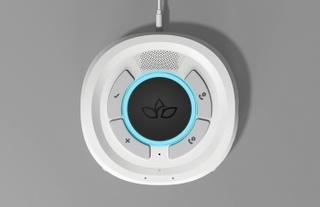
Image: Aloe Care Health
The Aloe Care Smart Hub features quite a few buttons. And since the labels aren’t easy to see without glasses, we recommend spending some time getting to know what each button does.
- Emergency button: black button in the center
- Request check-in from primary caregiver: button in the 2-o’clock position
- Request check-in from any caregiver: button in the 5-o’clock position
- Yes: button in the 10-o’clock position
- No: button in the 7-o’clock position
- Volume controls: on the right side of the device, with the “up” button furthest away from you and the “down” button closest to you
There’s also a light around the emergency button. When you walk by the hub at night, the light turns on and reduces your risk of tripping. When one of your caregivers calls you to check in, the light will turn blue.
Finally, you’ll see two grey nubs on the front of the base station. These are motion sensors. The Smart Hub also houses a temperature sensor and air quality sensor, which detects volatile organic compounds (VOCs) and carbon dioxide levels.
The Aloe Care Smart Hub is totally useless in the event of a house fire or carbon monoxide leak. Make sure you have working smoke detectors and CO alarms installed throughout your home.
What's in the box
The Aloe Care Smart Hub comes with the following:
- Power cord
- Help button
- Necklace adapter
- Wristband adapter
- Setup guide
- Caregiver guide
- Product manual

Image: Cathy Habas, SafeWise
Wearable button
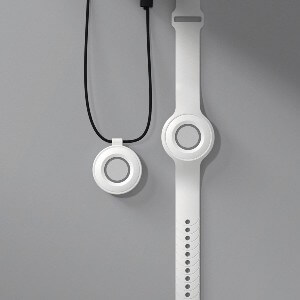
Image: Aloe Care Health
The Smart Hub comes with a small help button that snaps into a wristband or necklace accessory. You must stay within 200 feet of the Smart Hub for the button to work. Although that seems very limited compared to LifeFone’s industry-leading 1,400-foot range, it’s sufficient for many homes.
There’s no microphone or speaker in the help button, so staying close to the Hub makes it easier to hear and talk to the professional monitors or your loved ones.
Mobile Companion
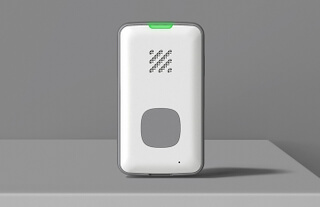
Image: Aloe Care Health
The Mobile Companion can detect falls, get help, and facilitate two-way talk. It can be worn around your neck or tucked into a pocket. Grab it when you head out into the yard or go to the store. It has an unlimited range in most US cities but may not work well in rural or mountainous regions due to fewer cell towers.
The device also tracks your location via GPS, Wi-Fi, and cellular data, which is the same technology used in our long-time favorite mobile alert device, the Medical Guardian Mini.
The fall detection option can be toggled on or off in the Aloe Care app. Keeping it off allows the battery to last up to five days between charges. The mobile device should be worn around your neck for more accurate fall detection.
What's in the box
Aloe Care's Mobile Companion comes with the following:
- Mobile companion and quick-release lanyard
- Charging station
- Setup and product guide
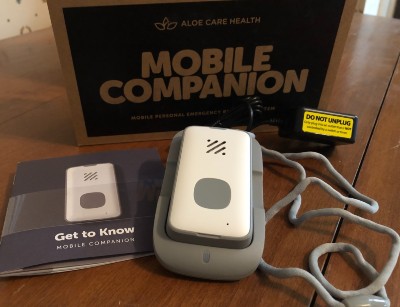
Image: Cathy Habas, SafeWise
Wall-mounted sensors
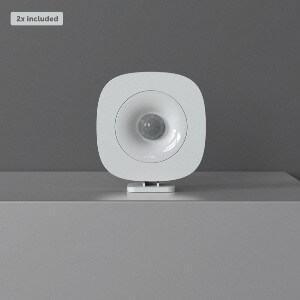
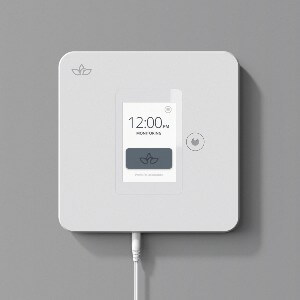
Images: Aloe Care Health
Two motion sensors and a wall-mounted fall detection sensor/wall button round out Aloe Care’s equipment line. The motion sensors not only detect your movement but also learn your daily routine. If you stop walking past the motion sensors at your usual times, the app alerts your Care Circle so someone can check on you.
The wall-mounted fall sensor is totally unique among medical alert systems. It uses radio waves to determine if you’re on the floor and not moving. It also features voice activation and a help button.
How to use Aloe Care
With extra features comes a slight learning curve. Here’s how to use your Aloe Care equipment.
Getting help from the monitoring center
There are four buttons that connect you to the monitoring center:
- Press the big black button in the center of the Smart Hub. If you press this by mistake, just hit the X button in the 7-o’clock position to cancel.
- Press the wearable button on your wristband or pendant. If possible, move closer to the Smart Hub so the monitors can hear you.
- Press the gray button on the Mobile Companion.
- Tap the gray button on the wall-mounted fall sensor.
Using voice activation cues
- Keep saying “Emergency” until you hear a chime from the Smart Hub or wall-mounted fall sensor. The device will ask you to confirm that you need help.
- Say “Emergency” one more time to connect to the monitoring center.
- If you want to talk to your caregivers instead, say “Cancel” after the Hub asks you to confirm that you need help. Then, say, “Call my family.”
Our main criticism here is that it would be easier to say, “Call my family” right off the bat.
The device also has to recognize the word "emergency" five times before it will trigger an alarm, which seems like too much. Before we figured this out, we shouted it just three or four times before pausing and grumbling a bit. Don't do that. Stay calm and speak as loudly and clearly as you can.
Getting help from caregivers
- To ask your primary caregiver to check in, press the Smart Hub button in the 2-o’clock position, which has the image of a phone receiver and the number one.
- To ask any available caregiver to check in, press the button in the 5-o’clock position, which has the image of a phone receiver and the number two.
- Wait for your caregiver(s) to call you through the Smart Hub. Accept their call by pressing the checkmark symbol in the 10-o’clock position. If you’re unable to press the button, the call will automatically connect after five rings.
- You can reject a check-in call and prevent the automatic connection by pressing the X button in the 7-o’clock position.
Caregivers can start a three-way call with the monitoring center from the mobile app if they decide you need prompt attention.
Aloe Care setup and installation
Setting up the Aloe Care Smart Hub is as simple as plugging it in and pushing a button. Seriously. It takes about three minutes from start to finish, and most of that time is spent just waiting for the hub to give further instructions.
Once it's plugged in, the hub light starts pulsing gently. Be patient: in our case, it took exactly 70 seconds for the Aloe Care hub to say, "Welcome. Let's get started."
Next, the hub says, "If a caregiver is present to help with install, please have them open the caregiver smartphone app."
Whoops, we hadn't set that up yet.
Fortunately, it wasn't necessary to have the app ready to go. After a brief pause, the hub continues by saying, "If you're installing for yourself, press the center button on this device to continue." Easy.
The hub spends the next 15 seconds or so connecting to LTE and says, "You have successfully connected your Aloe Care Smart Hub. Finalizing setup. Your Smart Hub may need to restart during this process."
Wait for another 40 seconds. Finally, the hub will say, "Your smart system is fully set up and ready to use."
What happens if a caregiver sets up the hub?
On the Aloe Care app, your caregiver can choose to connect the Smart Hub to Wi-Fi right away. They'll need to know the network name and password. Our hub connected without a hitch (and with our track record of Wi-Fi woes, that's impressive).
Setting up the Aloe Care Mobile Companion and other devices
To set up the Mobile Companion, plug in the charging cradle and place the Mobile Companion on it so that the gold pins line up. Both the charger and the mobile device should light up.
Then, open the Aloe Care app and tap Add a Device from the home screen. Tap Mobile Companion followed by Ready to Go.
Our Mobile Companion connected within 40 seconds, but it may take a couple of minutes if your area has a weaker cell signal.
That's all there is to it!
Use the same process to set up other devices, like motion sensors or the wall-mounted fall detection panel.
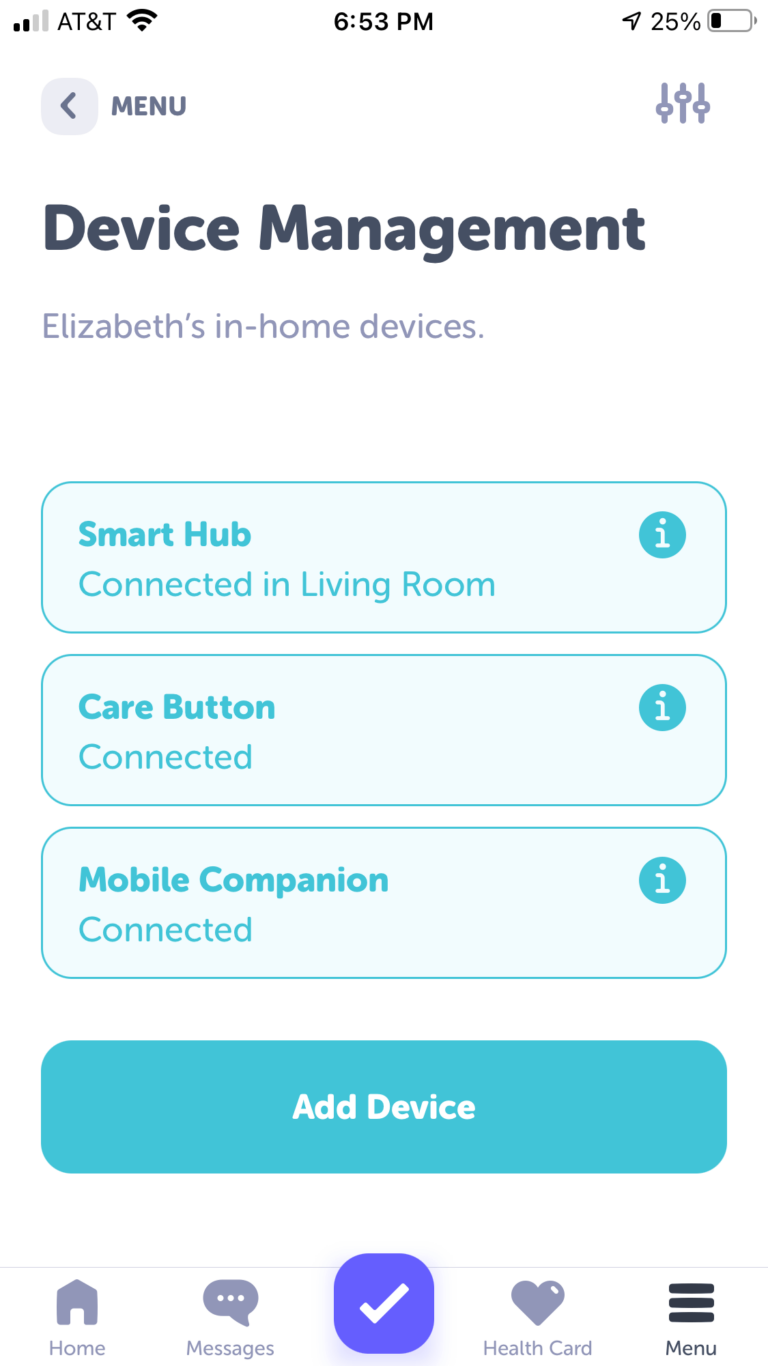
Aloe Care smartphone app
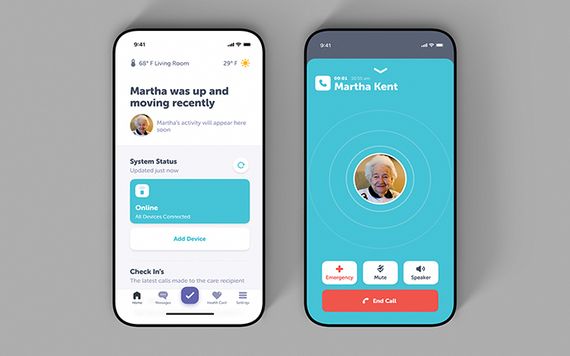
Image: Aloe Care Health
The Aloe Care caregiver app provides a central location for your friends, family, and medical professionals to stay up to date on your activity. Here are some of the things they can do through the app, depending on their permissions:
- Call you through the Smart Hub
- See your check-in call requests
- View fall detection or emergency alerts
- See whether the Smart Hub is connected properly
- View data like home temperature and air quality
- See when you last walked past the motion detectors
- Share quick updates with other caregivers
- See which caregivers have checked in with you and when
- Pay your Aloe Care bill
If you connect to the monitoring center, your Care Circle stays in the loop. They’ll get a notification on the app and get real-time updates about what’s going on and how the monitoring center responded.
You and your primary caregiver should work together to invite your loved ones to join your Care Circle. There’s no limit on how many people you can add, but you also don’t have to add everyone you know.
Along with the usual folks like your children or grandchildren, consider adding a friend or neighbor who can get to you quickly.
Aloe Care smart home features and compatibility
Aloe Care is one of the few medical alert systems embracing smart home technology and equipment integrations.
Wi-Fi or 4G
The Aloe Care Smart Hub can use either Wi-Fi or 4G LTE as its primary internet connection. There is no landline/Ethernet option.
If you use Wi-Fi, 4G can be used as a back-up option during internet outages.
Note that the automatic fall detection sensor requires Wi-Fi and doesn’t work with 4G.
Zigbee, Bluetooth, and radio frequency
Aloe Care can be linked to other equipment—including other personal emergency response systems (PERS)—using Zigbee, Bluetooth, or radio frequency. This allows you to expand your medical alert system or create smart home automations that simplify your life.
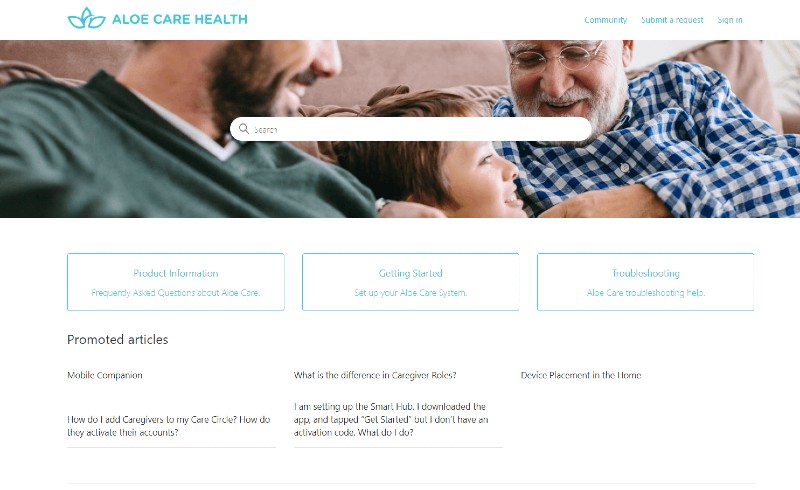
Image: Cathy Habas, SafeWise
Aloe Care customer service and support
Aloe Care is too new to have a profile on Trustpilot or Better Business Bureau. There are also hardly any Google reviews or app reviews to consult. So we’re not sure how easy it is to cancel the service or whether there are persistent problems with the equipment. But the few reviews that do exist are all positive.
We like seeing article libraries, community help forums, and more than one way to contact a company, all of which Aloe Care provides. But the community forums are a ghost town, probably because the company doesn’t have a substantial customer base yet.
We used the chat feature to clarify a few policy questions, and we were happy with their speed of service and precise answers.
Final word
We like Aloe Care’s caregiver-centric approach for better health care collaboration. We also think the motion sensor system offers a clever alternative to more intrusive check-ins. Compared to other medical alert systems, Aloe Care seems to offer a lot of value for your money and leaves your dignity intact. We don’t see any red flags that would make us steer clear.
Aloe Care FAQ
Right now, Aloe Care only uses and recognizes English. But you don’t need a perfect accent, since the system was designed to be used by English language learners too.
Aloe Care hopes to release Spanish and Mandarin versions in the future.
Aloe Care Health is a medical alert system with voice control, fall detection, motion detectors, environmental sensors, and a caregiver app.
Aloe Care Health works by connecting you to caregivers or a professional monitoring center when you need help. You press a button or use your voice to interact with the equipment. This medical alert system can also call for help automatically if you don’t move past the motion sensors for an extended period of time or if the fall detection sensors are triggered.
How we reviewed Aloe Care
For our Aloe Care Health review, we looked at the company’s technology, policies, and pricing structure and compared it to industry leaders, including those on our Best Medical Alert Systems page. We also spoke with Aloe Care representatives, watched an Aloe Care demo, and used their customer service portal as mystery shoppers.
Learn more on our methodology page.
Recent Articles
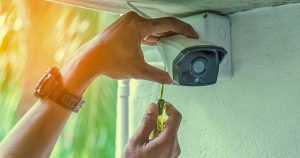



The post Aloe Care Review appeared first on SafeWise.
Article source here: Aloe Care Review


